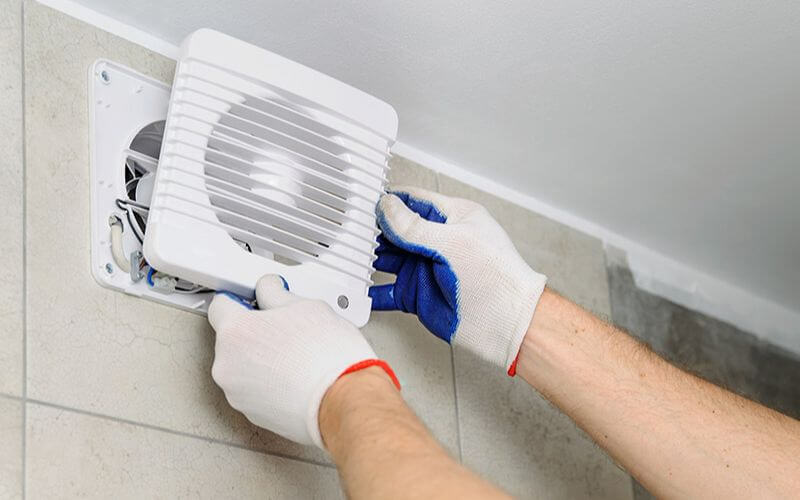Even though I took a shower, water was dripping in the bathroom. When I investigated the source, I discovered that it came from the bathroom ventilation fan. You’re probably at a loss for what to do about it, which is why you’ve come here. Don’t worry; we asked the professionals what to do about the bathroom Vent Fan dripping water in winter.
If your bathroom exhaust fan dripping water, one of the following must be done:
- Insulate the ductwork
- Inspect the damper.
- Examine the ventilation cover
- Keeping the fan clean
- Adjust the fan’s position
- Change the fan
- Clean the fan
Table of Contents
TogglePlease continue reading to learn what causes dripping and how to fix it. I’ll also tell you whether or not you should leave the bathroom fan on while you’re in the shower. Let’s get started!
How Can I Check If My Fan Is Dripping Water?
A bathroom fan removes moisture from the air and keeps mold and mildew from growing. With each use, bathrooms can become damp. As a result, bathrooms should be equipped with extractor fans and windows to promote proper ventilation and prevent the growth of these undesirable species in that area of the house. The fan, on the other hand, may drip water.
Water draining from a device designed to remove moisture from your bathroom can be a problem. Now, you might be thinking why is my bathroom fan dripping water? There may be several reasons for it. These include duct condensation, water on the roof, and improper bathroom fan installation. Let us go over each one separately.
Also, Read: How To Drain Water from An Evaporative Cooler?
Condensation in Ducts:
When warm or moist air meets cool air, condensation occurs. In the winter, warm air from the bathroom flows into the attic or outside, colliding with cold air and condensing. The condensing water is piped back into the bathroom.
During the summer, humid outside air can collide with the pipes cooled by the home’s air conditioning system. Condensation and water drip down the plumbing and end up in the bathroom vent.
Water From The Roof:
Ice can form on the roof during the winter. It can get into your bathroom ducts and vents if it melts.
Alternatively, the vapor barrier on the roof may not have been properly installed. When condensation occurs, water collects on the roof due to inadequate insulation. This will eventually reach your home’s ducts leading to the bathroom.
Incorrect Bathroom Fan Installation:
Of course, if the bathroom fan is not installed correctly, there could be a gap between the wall and the fan. When it rains, these gaps allow water to seep into the bathroom. Allow a professional technician to perform this work to ensure it is done correctly.
How Do You Repair A Leaking Bathroom Fan?
What to do now that you know what to look for if your bathroom fan leaks water? Here are some solutions to this problem:
Duct Insulation:
Insulation is essential for protecting your ducts from the elements. This allows you to control the temperature in the duct and reduce the possibility of condensation. It may contain some insulation, but it no longer fits. It could have slipped down over time, leaving certain duct parts exposed.
You could also have an issue with your attic insulation. Condensation and water droplets form when cold air from outside meets warm air from the bathroom outlet. To avoid exacerbating the problem, ensure that the attic insulation is in good condition.
The problem may arise due to air vents. So must check Where Should Cold Air Returns Be Located In the Basement?
Check The Damper:
This refers to the bathroom duct valves or flaps. A faulty damper can obstruct proper airflow and allow water into the ducts, resulting in leaks and drips in your bathroom. Have it inspected by a professional and, if necessary, replace the damper.
Examine the Vent Cover:
The roof is exposed to extreme weather conditions due to the ventilation cover. This means that it can be damaged by external factors, such as water entering the vents. Check whether any repairs are required or if the entire vent cover needs to be replaced. Allow a professional to do this to ensure proper installation.
Reposition The Fan:
The placement of the fan could be the source of the issue. If your fan is directly above your shower or bath, it is drawing in the warmest air, and condensation will almost certainly form when it meets the cold air in the duct.
Position the fan away from the bath and shower so that the air cools slightly before being sucked out of the room by a professional. This reduces the possibility of condensation in the ducts and water dripping into your bathroom vents.
Change The Fan:
Sometimes the fan is so bad that you can’t help but replace it. As the usage of your bathroom increases, you may need to increase the size and capacity of your fan.
Newer models are more effective at removing moisture from the air.
Bathroom ventilation fans have a lifespan of 5 to 10 years. It quickly wears out and can prevent you from getting enough air to improve the humidity in your bathroom.
Clean The Fan:
This should be done regularly. Dirty fans obstruct proper airflow and pose a fire hazard. Your bathroom vents may drip if they become clogged.
Should I Leave The Bathroom Fan On While I Take A Shower?
Leaving the fan on while in the shower helps keep the moisture out. Warm air is quickly expelled from the room by fans. It will be much easier to get rid of the stuffy air this way.
We also recommend that after bathing, you leave the fan running for 10-15 minutes to ensure that all moisture is expelled from the bathroom and its vents. Effective fan operation aids in the prevention of moisture and condensation issues.
Conclusion:
There are several options for dealing with dripping bathroom fans. Now you know all the preventive measures to take to keep the bathroom vent from dripping water. We recommend that first, you determine which one applies to your situation or have it checked by a professional to resolve the issue quickly.
FAQ
Do bathroom fans need maintenance?
Vent fans in bathrooms need to be cleaned frequently. Every bathroom in your home should have an exhaust fan that is vented to the outside, and you should run it anytime you shower or take a bath, as well as for 15 to 20 minutes thereafter, to eliminate excess moisture that can lead to the growth of mold and mildew.
How do I stop condensation in my exhaust duct?
Reduce the humidity in the area around the air ducts. If a dehumidifier helps to lessen condensation, consider getting one. Any ducts that are obstructing airflow should be cleaned often. Keep your air filters clean, and change them out every three months.
How do I stop my bathroom fan from dripping?
- replacing the extractor.
- Lag the duct pipe that is located in the loft.
- Determining whether the duct pipe in the loft is obstructed by looking into it.
- Replacing the vent’s end grille on the exterior wall (this had fallen off).
Why does my bathroom exhaust fan drip water?
After taking a shower, if you observe water dripping from your bathroom exhaust fan, there may be condensation in the duct. The warm bathroom air becomes chilly in the winter due to the freezing attic or outside temperatures. Tiny droplets of condensed air fall back via the conventional duct system.





















